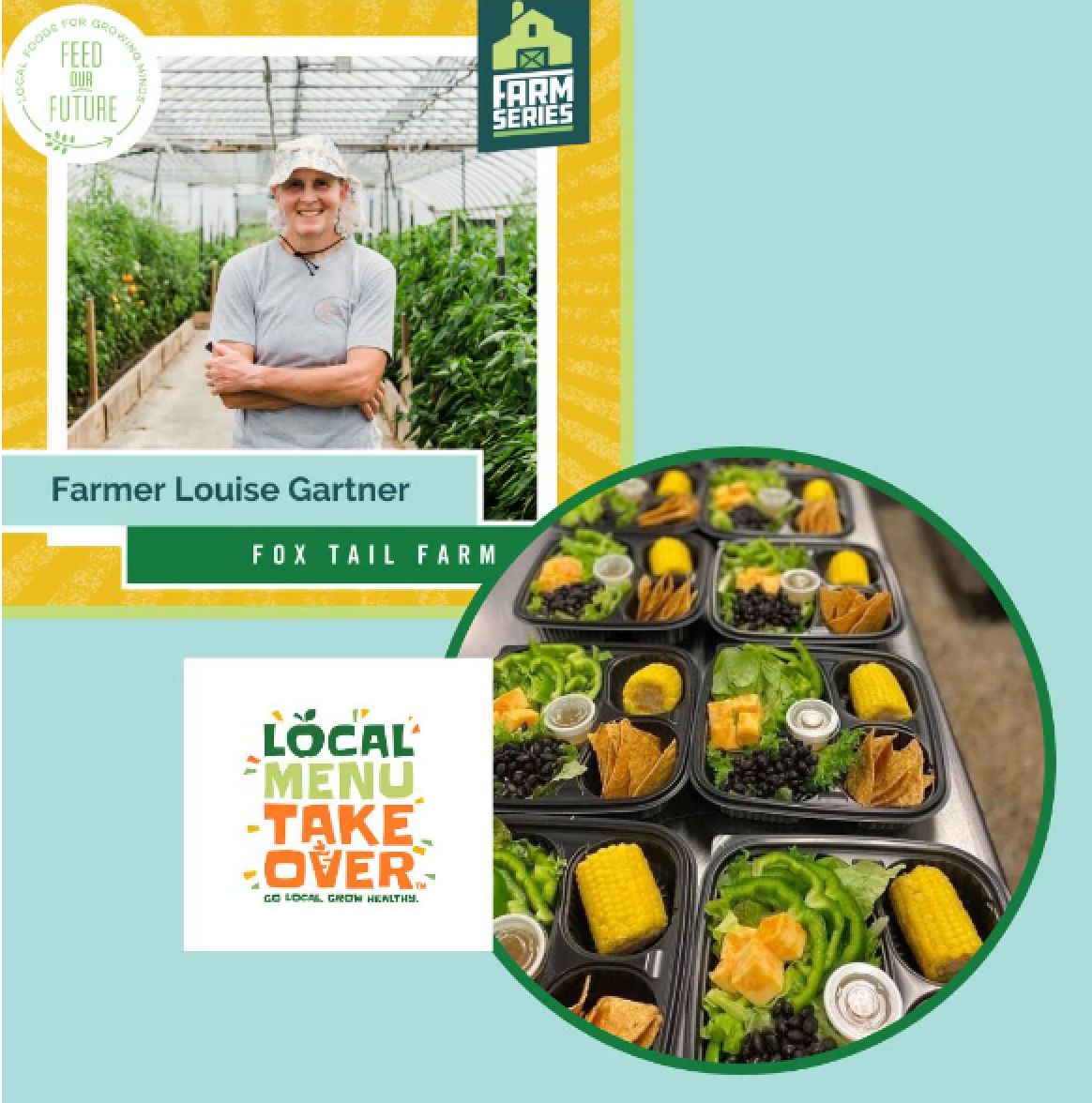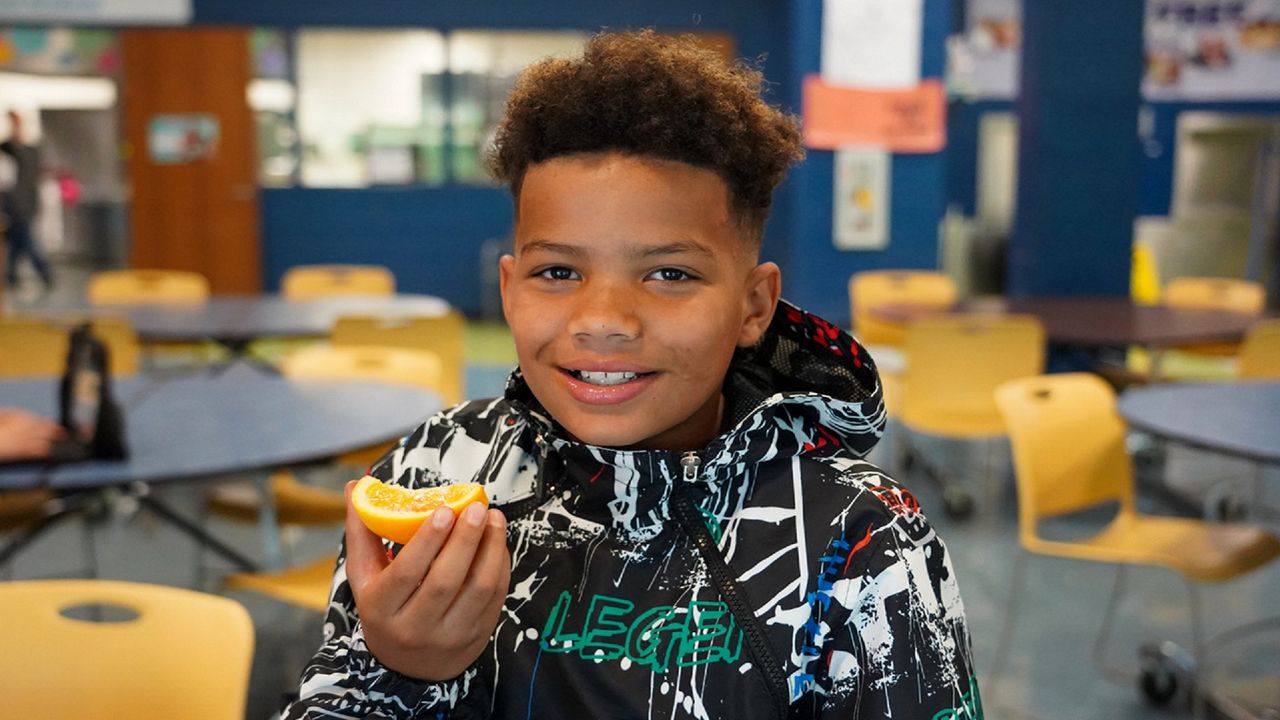CINCINNATI — Four local school districts are taking part in a pilot program to raise awareness about connections between schoolchildren and where the foods they eat every day at school are grown.
What You Need To Know
- Four Greater Cincinnati school districts committed to serving locally sourced meals this week as part of Farm to School Month
- The Feed Our Future’s Local Menu Takeover is a pilot program started last year in Northeast Ohio
- The program educates students about the local food ecosystem and supports schools in their procurement of products from regional farms
- A secondary goal of the program is to support small to mid-sized food growers and culinary artisans
The Feed Our Future’s Local Menu Takeover is serving locally sourced meals to select schools as part of Farm to School Month. The program works with school districts to create a pre-planned menu prepared using all-local ingredients or items.
In this context, local means anything within 250 miles of where the food is being shipped. But three of the farms are within a 45-minute drive from downtown Cincinnati.
The purpose of the program is to teach children and their families about the importance of local food while also supporting farmers and food businesses that produce them.
Local districts taking part this year include Cincinnati Public Schools, Milford Exempted Village Schools and West Clermont Local School District in Ohio, and Campbell County Schools in Northern Kentucky.
The pilot started Monday, Oct. 3 and runs through the rest of the school week.
“We want to create all-local meals and prove that it can be done in a way that is meeting the child nutrition (guidelines) and is also easy to replicate,” said Kristine Cahall-Dosch, Farm to School coordinator for the Greater Cincinnati Food Policy Council. The agency operates under the local environmental nonprofit Green Umbrella.
Using local food to feeding the mind and body
Districts taking part in Local Menu Takeover serve four meal concepts throughout the school year. They’re allowed to serve them to any of the schools within their district at any time. The program tries to be mindful of things like budget, staffing capacity, and student preferences.
Each district got to choose between seven meal concepts — two breakfasts, three entrees and two desserts. Each meal featured ingredients like eggs and produce sourced from farms in Ohio, Kentucky and Indiana.
They also included pre-made items created by local food businesses using ingredients grown in Ohio. Examples include yogurt parfaits and pizza bagels.
This week, each of the four districts are serving at least one of the concepts to “make a big splash” at to start Farm to School month, Cahall-Dosch said.
CPS is serving grown corn, yellow squash, watermelon, apples, honey-apple salsa and vegetable soup from Frisch’s. They're all examples of grown or produced food items from Greater Cincinnati that the district serves to its students every day.
“National Farm to School Month gives Cincinnati Public Schools a chance to showcase all the wonderful, nutritious foods provided by our local farmers,” said Jessica Shelly, the district’s director of student dining services.
Shelly said 90% of the district’s milk comes from Ohio dairy farms, and more than 50% of its produce comes from local farms.
“This impacts both our students and the local economy,” she added. “Students are getting the fuel they need to thrive in the classroom while CPS is investing back into Ohio communities.”
CPS, which Cahall-Dosch described as being “extremely experienced in purchasing local foods,” is serving the meals every day this week in its elementary schools. That means those foods could reach up to 10,000 students during the five-day school week.
Milford Schools, by comparison, is “newer to the game,” she said. The district plans to highlight one concept on Thursday to about 600 students. They plan to work through the remaining concepts at later times.
Krista Boyle, a spokesperson for Milford Schools, expressed excitement over the pilot.
As part of the program, Milford elementary school students are getting a Cinna Bar Bistro Box for breakfast and a Pear Keen Crumble with their lunch. Both items contain food items sourced from Ohio.
Milford Schools is tracking how many students take part by school to gather some baseline data. They’ll use that information to determine how to move forward in the future, Boyle said.
“We believe it’s important for our students to be able to connect to their community and for our district to directly support local businesses and farmers,” she added. “Right now, we’re excited to familiarize our students and families with the idea of locally sourced food.”
Helping local schools 'Feed Our Future'
The organization Feed Our Future launched Local Menu Takeover in Northeast Ohio during the 2020-2021 school year. The program expanded to Greater Cincinnati for this year.
The Greater Cincinnati Food Policy Council — which works with communities and governments to create sustainable food systems — sent the application in March to schools in Southwest Ohio, Southeast Indiana and Northern Kentucky.

Each of the selected districts is a member of the Unified Purchasing Cooperative of the Ohio River Valley (UPC) or has taken part in Feed Our Future programming.
UPC is a collection of 60-plus schools and organizations that join forces in purchasing food. They work together to negotiate better pricing by offering vendors high-volume sales opportunities. Recently, they’ve placed more of an emphasis on local vendors.
Cahall-Dosch called working with purchasing cooperatives an innovative aspect of Feed Our Future. The cooperatives help farmers to plan their crops based on expected demand. For the schools, the cooperatives streamline what's an otherwise complex purchasing process.
As part of a larger USDA Farm to School Implementation grant, each district in the Local Menu Takeover also received $2,500 from the Greater Cincinnati Regional Food Policy Council.
The goal of the grant, Cahall-Dosch said, is to defray some of the cost of purchasing small quantities of foodstuff as part of the pilot. She said costs will drop once districts buy items in larger quantities through a bidding cooperative.
“These partnerships can seamlessly coordinate demand on a regional scale while securing a competitive price,” she added.
Growing support for local farms, food businesses
A major part of the Feed Our Future program is the support it offers to local farms and food businesses. There's a particular emphasis on small to mid-sized farms, as well as what Cahall-Dosch describes as “value added culinary artisans." One example she gave is a woman-owned business called Dough Go’s in Northeast Ohio. It makes breakfast bars that include only products grown in the state.
“If it weren’t for this program, a lot of these sales probably wouldn’t have been there otherwise,” Cahall-Dosch said. “Actually, I know they wouldn’t have otherwise.”
Another component of the program is education. Each farm, for example, produces baseball card-like handouts for students. The cards include a photo of the farm, information about its history and details about the crops it grows and/or animals it raises.
Fox Tail Farm, for instance, started in 2014 on a then-empty 5-acre lot in New Richmond, Ohio. Within two years it became certified organic. Today, the farm grows a variety of vegetables, both in its open fields as well as in high tunnels, or hoop houses. The high tunnels allow the farm to grow year-round and keep fresh vegetables through all four seasons.
“It’s about giving students a taste of what these farms are like,” Cahall-Dosch said. “Maybe they can’t go out to the farm but they can see the farm space, they can learn a little bit more about their crops, and really understand where their food comes from.”
